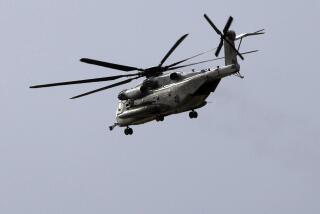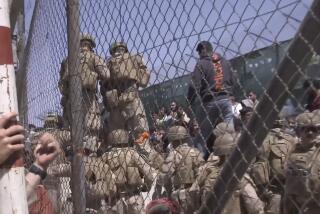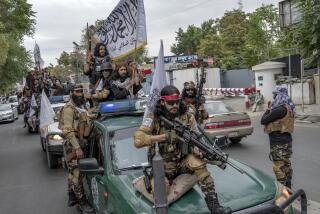Marines focus on civilian safety in Afghanistan
- Share via
Reporting from Kabul, Afghanistan, and Camp Leatherneck, Afghanistan -- Heading into battle to seize a Taliban stronghold, U.S. Marines are keenly aware of one factor that could snatch defeat from the jaws of victory: Afghan civilian casualties.
Deaths of noncombatants in clashes involving Western troops and insurgents are one of the bitterest points of contention between President Hamid Karzai and his foreign allies. So in the weeks leading up to the imminent offensive to take the Helmand River Valley town of Marja in southern Afghanistan, the Marines’ commander, Brig. Gen. Larry Nicholson, sat with dozens of Afghan tribal elders, drinking endless cups of sweet tea and offering reassurances that his top priority will be the safety of Afghan civilians.
“In counterinsurgency, the people are the prize,” Nicholson said in an interview at Camp Leatherneck, the U.S. base in central Helmand province that is the main staging ground for the offensive.
The Marja operation has been publicized for months by the Marines. One reason Nicholson has taken that unusual step is to give civilians plenty of warning, decreasing the chances they will be caught in crossfire.
It is not clear whether the Taliban forces will fight in Marja or melt away, to regroup and fight elsewhere. But at a minimum, the Taliban has had months of warning to plant booby traps and roadside bombs. The Marines are equipped with 70-ton Assault Breacher Vehicles that fire line charges to detonate buried bombs in the path of advancing troops.
To minimize civilian casualties in the event of a battle, leaflets have been dropped in the Marja district, urging residents to get out of the area.
Many Afghans, however, are reluctant to leave homes and farms unattended. For cultural reasons, Pashtun tribesmen are also often unwilling to let women and children take shelter elsewhere without a male family member.
The Marja assault will be the largest joint effort by U.S., coalition and Afghan troops since the Taliban was chased from power in 2001, and the first major offensive since President Obama’s decision to authorize sending 30,000 additional troops to the country.
It is also a test of whether a large-scale ground battle can be conducted in a densely populated setting without large numbers of civilian deaths and injuries. About 85,000 people live in Marja itself, and an estimated 45,000 more in outlying parts of the district.
When Marine battalions descended on Helmand province last summer, the commander of coalition troops in Afghanistan, Army Gen. Stanley A. McChrystal, was formulating strict new rules of engagement meant to protect Afghan civilian lives.
McChrystal’s focus on avoiding civilian casualties addresses repeated complaints from Karzai and other Afghan officials and reflects his view of the conflict as a counterinsurgency -- in which winning over civilians is crucial.
As they moved to seize a string of villages in the lower Helmand River Valley, Marine commanders were careful to limit the use of artillery and air power. Infantry troops were warned not to shoot at targets if there were civilians in the line of fire.
That restraint helped the Marines win a measure of acceptance from tribal elders. So did follow-up efforts to establish safety and governance: reopening bazaars, repairing irrigation canals, protecting local officials who were under Taliban threat.
“Until we can operate so the Afghan people believe that we are here to protect them in every way, we still have improvements to make,” McChrystal told reporters in Kabul this week. “It is unlikely we will be perfect as long as the levels of insecurity are as difficult as they are, but to the degree that the people can help us, we’ll stay completely focused on this.”
To rally support in Marja, Nicholson has met repeatedly with the district’s elders in tribal gatherings known as shuras.
Sitting recently with a dozen of what he described as the town’s most important elders, Nicholson asked them to spread the word among their clansmen: Stay indoors when the fighting begins.
Any battle damage to homes, farms and business will be repaired, and compensation paid.
Hundreds of people have already fled the town, according to the International Committee of the Red Cross and provincial refugee officials. Some are taking shelter with relatives elsewhere in the province, or seeking safety in the provincial capital, Lashkar Gah.
But Nicholson and others expect the Taliban to push civilians into harm’s way, in hopes that some will be killed and provide the insurgency with a propaganda victory.
“We are up against a cunning, immoral enemy who will try to exploit war among the people,” said British Maj. Gen. Nick Carter, commanding general of NATO’s Regional Command South, which includes Helmand province. “We want to make sure all efforts are made to limit collateral damage.”
At some meetings with elders, Nicholson has been accompanied by the commander of the Afghan forces, Brig. Gen. Mahayoodin Ghoori. His presence at Nicholson’s side at the shuras is meant to convince elders that Afghan soldiers are full partners with the Marines in this operation.
The presence of Afghan troops is expected to be crucial to Marines’ efforts to distinguish friend from foe in Marja -- determining, for example, whether a young fighting-age man is a farmer trying to watch over his lands or an insurgent trying to blend in with the populace.
But the Afghan forces are not infallible, either. Last week in neighboring Kandahar province, Afghan border police shot dead seven men they took to be Taliban fighters crossing over from Pakistan.
It turned out the slain men were unarmed villagers, probably gathering firewood, local officials said.
“It is natural that townspeople are afraid -- afraid of losing their lives in this fighting,” said Abdul Hahad Hemandwal, an elder in Nad Ali district, which encompasses Marja. “But we have had lots of meetings with U.S. commanders, and we think they are trying very hard to avoid that.”
More to Read
Sign up for Essential California
The most important California stories and recommendations in your inbox every morning.
You may occasionally receive promotional content from the Los Angeles Times.













